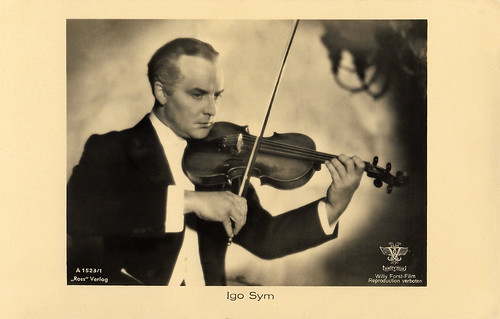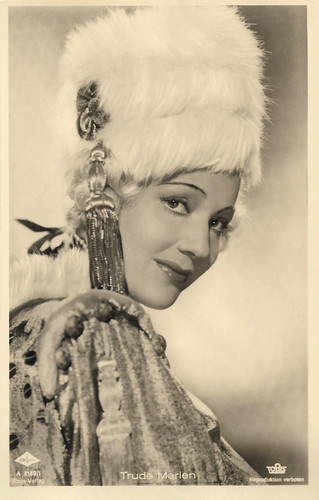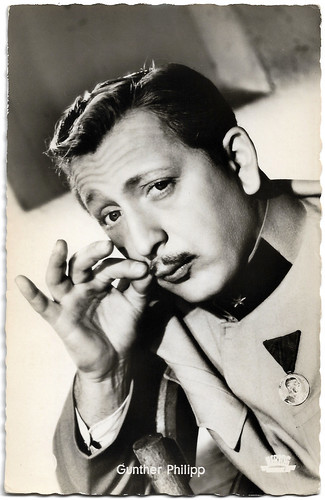
German postcard by Ross Verlag, no. A 3149/2, 1941-1944. Photo: Tobis. Willi Forst in Bel Ami (Will Forst, 1939).
Willi Forst (1903-1980) was a darling of the German-speaking public. He was also one of the most significant directors, producers, writers and stars of the Wiener Filme, the light Viennese musical comedies of the 1930s. Bel Ami (Willi Forst, 1939), loosely based on the novel by Guy de Maupassant, would be his best-known film. He also played the title role, which would be his alter ego from then on. Forst was much courted by the Nazis but succeeded in avoiding overt political statements, concentrating on the light entertainment for which he was famous and which was much in demand during the war.

Spanish leaflet by Films Selectos, Suplemento Artistico, no. 176, 24.2.1934. Photo: Cine-Allianz. Hans Jaray in the Biopic Leise flehen meine Lieder / Gently My Songs Entreat (Willi Forst, 1933).
Leise flehen meine Lieder (Willi Forst, 1933 was Forst's first film direction, a Biopic about the life of composer and musician Franz Schubert. Leise flehen meine Lieder was so popular throughout Europe that it was reshot in a British version for the English language market as The Unfinished Symphony (Willi Forst, Anthony Asquith, 1934), also with Austrian actor Hans Jaray in the lead. Forst also wrote the scenario. The co-author of the original was Walter Reisch, who in later Hollywood exile would script Ninotchka (Ernst Lubitsch, 1939) and Gaslight (George Cukor, 1944), and work with Billy Wilder.

Dutch photo. Front of the Rembrandt Theatre in Amsterdam, The Netherlands. On show was Leise flehen meine Lieder / Gently My Songs Entreat (Willi Forst, 1933). A gift from Roloff de Jeu.
Leise flehen meine Lieder / Gently My Songs Entreat took on the love affair between composer Franz Schubert and the Countess Esterhazy. In Lieder, Hans Jaray starred as Schubert, Luise Ullrich, fresh from Max Ophüls’s Liebelei, was Schubert’s innocent love, future comedic superstar Hans Moser was her father, and Marta Eggerth was the seductive Czardas-dancing countess who disrupts the composer’s life. Robert von Dassamowsky in Senses of Cinema: "The orchestration of image, lighting, music and performance in Lieder suggests a unique personal style that had not been previously seen in the new musical film. The style-cum-genre genre was certainly Viennese from its very roots: theatrical and visual values of the Baroque, the near operatic equality of dialogue and music, and the balanced blending of all aspects of the film into a seamless Gesamtkunstwerk, or total work of art."

German collector card in the series 'Vom Werden deutscher Filmkunst - Der Tonfilm', album no. 11, picture no. 103. Photo: Tobis-Sascha-Film / Ross Verlag. Paula Wessely in Maskerade/Masquerade in Vienna (Willi Forst, 1934).
Distinguished stage actress Paula Wessely played her first major film role as Leopoldine Dur in Forst's second film, the Operetta Maskerade / Masquerade in Vienna (Willi Forst, 1934) alongside Adolf Wohlbrück. Maskerade, set in the Viennese high society of about 1900, was a hit that launched Forst's fame as a significant director and made an instant star of Wessely. The exceptional script of this classic example of the Wiener Film was written by Walter Reisch and directed by Willi Forst. Essential to the visual success of the film was the contribution of director of photography Franz Planer, with his lively and beautifully lit compositions. Maskerade received an award for best screenplay at the Venice Film Festival and ultimately proved to be so successful internationally that Hollywood 'borrowed' the story for a new, but less welcomed version entitled Escapade (Robert Z. Leonard, 1935) with Luise Rainer.

German postcard by Ross Verlag / Das Programm von Heute für Film und Theater G.m.b.H., Berlin. Photo: Cine-Allianz. Pola Negri in Mazurka (Willi Forst, 1935).
Willi Forst rapidly developed himself into a four-way talent, as producer, director, writer and actor in German films. For Mazurka (Willi Forst, 1935), he lured Pola Negri back from Hollywood. She played a woman who was put on trial for murdering a predatory musician. The title refers to the Polish folk dance. Mazurka gained much popularity in Germany and became one of Adolf Hitler's favourite films. Warner Bros. acquired the U.S. distribution rights but shelved the film in favour of its own scene-by-scene English language remake, Confession (Joe May, 1937), which starred Kay Francis.

German postcard by Ross Verlag, no. A 1523/1, 1937-1938. Photo: Willi Forst-Film. Igo Sym in Serenade (Willi Forst, 1937).
In 1937, Will Forst founded his own film company, Willi Forst-Film. His first production was the drama Serenade (Willi Forst, 1937), starring Hilde Krahl, Albert Matterstock and Igo Sym. Forst considered a move to Hollywood the same year, but stayed in Vienna. Following Austria’s annexation to Germany in March 1938, Vienna’s film industry was wholly integrated into the structure and ideology of the Third Reich and given a specific cultural mission – the production of lavish musicals, costume dramas and other 'Vienna style' entertainment films for the Reich and its Axis partners. With strong control from Berlin, the new Viennese mega-studio Wien-Film echoed the concept of the Hollywood studio system more closely than had been normal in previous Austrian cinema development. Many Austrian talents at Ufa in Berlin, including Forst, returned home to participate in this new phase of Vienna’s industry.

Dutch postcard by M. B. & Z. (M. Bonnist & Zonen, Amsterdam), no. 1215. Photo: Godfried de Groot.
Austrian actress and singer Lizzi Waldmüller (1904-1945) had her breakthrough to stardom through her role as Rachel in Bel Ami (Willi Forst, 1939). Following the annexation of Austria in 1938, Willi Forst was much courted by the National Socialists but succeeded in avoiding overt political statement, concentrating entirely on the opulent period musical entertainment for which he was famous and which was much in demand. He changed the brash and ambitious ex-military man of Guy De Maupassant's novel into a likeable bon vivant and charmer in a dress suit. Bel Ami was made on the eve of the outbreak of the Second World War, at a time when Germany's going to war against France was already a very likely prospect. In Nazi Germany, the film industry was closely controlled by the Minister of Propaganda Joseph Goebbels. While Bel Ami was not conceived as an outright propaganda film, the theme of corruption in the French society and politics - prominently present in the Maupassant original - was well suited to the thrust of Nazi propaganda at the time the film was made.

German postcard by Ross Verlag, no. A 3169/1, 1941-1944. Photo: Wien-Film / Tobis. Trude Marlen in Operette / Operetta (Willi Forst, Karl Hartl, 1940).
Unlike the other directors of Wien-Film, Forst preferred to use relatively untested talent as co-stars, and thus managed to create stardom for several leading ladies: Lizzi Waldmüller, Ilse Werner, and Trude Marlen. Willi Forst directed curly-locked Trude Marlen in Operette / Operetta (Willi Forst, Karl Hartl, 1940), also starring Forst, Maria Holst and Dora Komar. The film was made by Wien-Film. It is the first film in Forst's 'Viennese Trilogy', followed by Wiener Blut / Vienna Blood (1942) and Wiener Mädel / Viennese Girls (1945). The film, a mix of an operetta film and a Wiener Film, portrays the life of Franz Jauner (1832–1900), a leading musical figure in Vienna.

German postcard by Film-Foto-Verlag, no. A 3765/2, 1941-1944. Photo: Hämmerer / Wien-Film. Marte Harell in Frauen sind keine Engel / Women aren't Angels (Willi Forst, 1943).
Forst was an extremely versatile genre filmmaker, who could as easily make a crime film, a contemporary melodrama or a sophisticated comedy. An example is the comedy Frauen sind keine Engel / Women aren't Angels (Willi Forst, 1943) starring Marte Harell, Axel von Ambesser and Margot Hielscher, which was also produced by Wien Film. During the seven-year Nazi rule in Austria, Willi Forst only made six films, none of them political.

German postcard by Kunst und Bild, Berlin, no. A 482. Photo: Wesel / Styria / Junge Film Union / Herzog Film. Hildegard Knef in Die Sünderin / The Sinner (Willi Forst, 1950).
Willi Forst had comparatively little success after the war except for the film Die Sünderin / The Sinner (Willi Forst, 1950) starring Hildegard Knef, which became a scandal because of the protests of the Roman Catholic church against its nudity, rare in contemporary German-speaking cinema, but which subsequently attracted an audience of seven million people. The film represented a major shift for Forst, who had previously been known for escapist films, which avoided controversial themes and embraced romanticised settings. Die Sünderin / The Sinner adopted instead a realist perspective, addressing taboo subjects like prostitution and euthanasia, which challenged the moral sensitivities of post-war West German society.

German postcard by F.J. Rüdel Filmpostkartenverlag, Hamburg-Bergedorf, no. 81/2. Photo: Junge Film Union / Herzog / Foto Wesel. Hildegard Knef in Es geschehen noch Wunder / Miracles Still Happen (Willi Forst, 1951).
Rebellious, gravel-voiced actress, chanteuse and author Hildegard Knef (1925-2002) was one of the most important film stars of post-war Germany. Despite the controversy, or perhaps because of it, Die Sünderin / The Sinner marked a turning point in Knef’s career, after which she appeared in notable Hollywood films such as the War film Decision Before Dawn (Anatole Litvak, 1951) and the romantic adventure film The Snows of Kilimanjaro (Henry King, 1952). Es geschehen noch Wunder / Miracles Still Happen (Willi Forst, 1951) was intended by Forst as a less risqué follow-up to his controversial Die Sünderin / The Sinner (Willi Forst, 1950).

West-German postcard by Kolibri-Verlag G.m.b.H, Minden-Westf, no. 2337. Photo: Sascha / Herzog / Michaelis. Günther Philipp in Kaiserjäger / Emperor Hunter (Willi Forst, 1956).
Austrian film actor Gunther Philipp (1918-2003) appeared in 147 mostly German films and TV productions, mainly in comic roles, like as Leutnant der Reserve Otto Schatz in Kaiserjäger / Emperor Hunter (Willi Forst, 1956). The film didn't revitalise Willi Forst's career. The following year, Forst directed his final film, after which he retired from the industry. IMDb cites him saying: "My style is no longer in demand: I go off, a little bit battered, but in proud greatness à la [Greta Garbo]. It is better to go than to be asked to go." Forst is today considered one of Europe's important early sound directors. In his study, Willi Forst. Ein filmkritisches Porträt', Italian film historian Francesco Bono notes that Forst's last film, Wien, die Stadt meiner Träume (1957), is more than a superficial narrative. It is a film that exposes the superficial, fictional image of Vienna promoted by Austrian cinema of the 1950s precisely as an illusion. That Vienna of your dreams exists only in film.'
Sources: Robert von Dassanowsky (Senses of Cinema), Ivo Blom (review 'Willi Forst. Ein filmkritisches Porträt' in TMG Online, 2011), Wikipedia (English and German) and IMDb.
1 comment:
Some wonderful images here!
Post a Comment